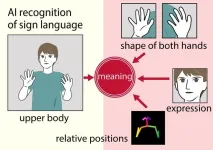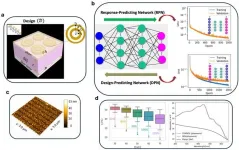(Press-News.org)
Indigenous students identified inadequate funding as a major barrier to completing post-secondary education according to a new study published in AlterNative: An International Journal of Indigenous Peoples.
The study surveyed Indigenous university students at Algoma University. The students, who identified as either First Nations or Métis, reported that they required multiple sources of funding, including government student loans and personal savings, to afford their post-secondary education. About two-thirds (69%) of students received funding for their education from First Nations sources, including funding from federal programs for Indigenous students.
“This research sheds light on helpful strategies to creatively support Indigenous students in post-secondary education,” says first author, Dr. Rose E. Cameron, (Anishinaabekwe), an Associate Professor of Social Work at Algoma University. “It also provides new insight into how institutions can help minimize the barrier Indigenous students face.”
The survey asked Indigenous students how universities can better support them. Students suggested that social events for Indigenous students, on-campus childcare, and mentorship opportunities for Indigenous students would help to decrease isolation and cultivate a sense of belonging in campus. The research findings underscored how resources centres, cultural events and mentorship opportunities can boost the resilience of Indigenous students by helping them feel included, supported, and socially connected on campus.
“The Anishinaabe Academic Resource Centre at Algoma University is a model for other institutions looking to support students with Indigenous ancestry,” says Deanna Naveau-Heyde (Mattagami First Nation), a research assistant at Algoma University. “It offers a host of culturally affirming events including Pow Wows, sharing circles, moccasin-making, visiting Elders and feasts.”
With more Indigenous students graduating from high school than ever before, it is important for programs to provide both cultural and financial support, say the researchers. “Funding and supports for Indigenous students needs to keep pace with their increase in numbers, which unfortunately has not been the case,” says Meghan Bird, a research assistant at the Factor-Inwentash Faculty of Social Work at the University of Toronto.
Nearly half (47%) of students in this study had children, with most students having 2-3 children in their care. In comparison, only 11% of non-Indigenous post-secondary students are parents. Nearly all the Indigenous parents in this survey were enrolled in university full-time. They reported that having children while in university can make finding housing, affording childcare, and balancing studies significantly more challenging.
“Most of the Indigenous students in our study faced significant financial difficulties, which can impact their ability to complete their studies,” said Esme Fuller-Thomson, Professor at the Factor-Inwentash Faculty of Social Work and Director of the Institute of Life Course and Aging at the University of Toronto. “While our study only surveyed Indigenous students currently enrolled in university, future research would benefit from surveying Indigenous students who had to leave school due to inadequate funding.”
For many Indigenous students, the transition from their home reservation to urban university campus is especially difficult. Many fear losing their connection to family, community, and culture.
The authors argue that institutions of higher education across Canada can benefit from surveying their students with Indigenous ancestry to better understand how to support them in their pursuit of higher education.
“All institutes of higher education should provide financial assistance and fund specialized resource centers to support their students with Indigenous ancestry academically and socially,” says Cameron.
Source Article
Cameron, R. E., Bird, M. J., Naveau-Heyde, D. D., & Fuller-Thomson, E. (2024). Creating a
“sense of belonging” for Indigenous students: identifying supports to improve access and success in post-secondary education. AlterNative: An International Journal of Indigenous Peoples,
Author’s Note
Rose E. Cameron (Anishinaabekwe) (PhD) is an Associate Professor in the School of Social Work at Algoma University, Canada. Meghan J. Bird (BASc Hons., MSW) is a Canadian Social Worker, Therapist, and research assistant at the Factor-Inwentash Faculty of Social Work at the University of Toronto. Deanna D. Naveau-Heyde (Mattagami First Nation) (BS Hons., CESD) is affiliated with Algoma University, Canada. Esme Fuller-Thomson (PhD) is Professor and Director at the Institute for Life Course and Aging, Factor-Inwentash, Faculty of Social Work at the University of Toronto, Canada.
END
Hot Jupiters are giant planets initially known to orbit alone close to their star. During their migration towards their star, these planets were thought to accrete or eject any other planets present. However, this paradigm has been overturned by recent observations, and the final blow could come from a new study led by the University of Geneva (UNIGE). A team including the National Centre of Competence in Research (NCCR) PlanetS, the Universities of Bern (UNIBE) and Zurich (UZH) and several foreign universities has just announced the existence of a planetary system, WASP-132, ...
University of Birmingham venture Dexter has demonstrated the power of its Dexter software platform in a study showing that people whose childhoods featured abuse, neglect or domestic abuse carry a significantly increased risk of developing rheumatoid arthritis or psoriasis in later life.
The starting point for the recently published study was a database of over 16 million Electronic Health Records, from which the Dexter software defined a cohort, one arm that was exposed to childhood maltreatment, and one arm that was not.
The software then checked the records over a 26-year period ...
The discovery of two new planets beyond our solar system by a team of astronomers from The University of Warwick and the University of Geneva (UNIGE), is challenging scientific understanding of how planetary systems form.
The existence of these two exoplanets - an inner super-Earth and an outer icy giant planet - within the WASP-132 system is overturning accepted paradigms of how ‘hot Jupiter’ planetary systems form and evolve.
Hot Jupiters are planets with masses similar to those of Jupiter, but which orbit closer to their star than Mercury orbits the Sun. There is not enough gas and dust for these giant planets to form ...
WASHINGTON, D.C. — Weddnesday, Jan. 15, 2025 — Nearly half of Americans (46%) think the country is headed in the wrong direction when it comes to the incoming president’s policies to lower healthcare costs, while 31% say it’s on the right track, according to the latest West Health-Gallup survey released today.
When viewed through a political lens, only Republicans are more positive than negative about the future of healthcare costs under the Trump administration; nearly three-quarters (73%) think the incoming administration’s healthcare policies are headed in the right direction. In contrast, 24% of independents and 3% of Democrats say the same. Democrats ...
Sign languages have been developed by nations around the world to fit the local communication style, and each language consists of thousands of signs. This has made sign languages difficult to learn and understand. Using artificial intelligence to automatically translate the signs into words, known as word-level sign language recognition, has now gained a boost in accuracy through the work of an Osaka Metropolitan University-led research group.
Previous research methods have been focused on capturing information about the signer’s ...
Nearly a third of people in the U.S. have been exposed to unregulated contaminants in their drinking water that could impact their health, according to a new analysis by scientists at Silent Spring Institute. What’s more, Hispanic and Black residents are more likely than other groups to have unsafe levels of contaminants in their drinking water and are more likely to live near pollution sources.
The findings, published in the journal Environmental Health Perspectives, add to growing concern about the quality of drinking water in the United States and the disproportionate impact of contamination ...
CLEVELAND, Ohio (Jan 15, 2025)–It’s not easy being a woman. Just look at the statistics. Women are more likely to have such debilitating conditions as osteoporosis, migraines, Alzheimer disease, depression, multiple sclerosis, and brain tumors. Sex hormones are often blamed. However, a new study suggests no link between hormone therapy (HT) and common brain tumors known as gliomas. Results of the study are published online today in Menopause, the journal of The Menopause Society.
The debate over the risks and benefits ...
CLEVELAND, Ohio (Jan 15, 2025)—Artificial intelligence (AI) is positioned to make a major impact on almost every industry, including healthcare. A new study suggests that machine learning models can more quickly and affordably identify women with severe subjective cognitive decline during the menopause transition, effectively opening the door to better management of cognitive health. Results of the study are published online today in Menopause, the journal of The Menopause Society.
Subjective cognitive decline refers to a person’s ...
Light absorption is a cornerstone for several applications such as solar cells, photodetectors, and optical sensors, to name a few. Yet, the trade-off between the thickness of the absorber and its efficiency has long limited the performance of such devices. The goal in this investigation is to get the best of both worlds—ultra-thin materials with maximized absorption.
In a recent paper published in Light: Science & Applications, a group of researchers from King Abdullah University of Science and Technology (KAUST), led by Prof. Ying Wu and Prof. Xiangliang Zhang (now at University of Notre Dame), successfully put forward an efficient broadband light absorber ...
Low back pain is a leading cause of disability worldwide with many treatments, such as medication, often failing to provide lasting relief. Researchers from the University of Sydney’s Centre for Rural Health have uncovered a possible solution. Their study, published in JAMA Network Open, found integrating lifestyle support into back pain care could reduce disability and enhance quality of life.
The randomised controlled trial included 346 participants from across Australia, all of whom had chronic low back pain and at least one lifestyle risk factor, such as obesity, poor diet, sedentary habits, or smoking. Participants were randomly assigned ...



